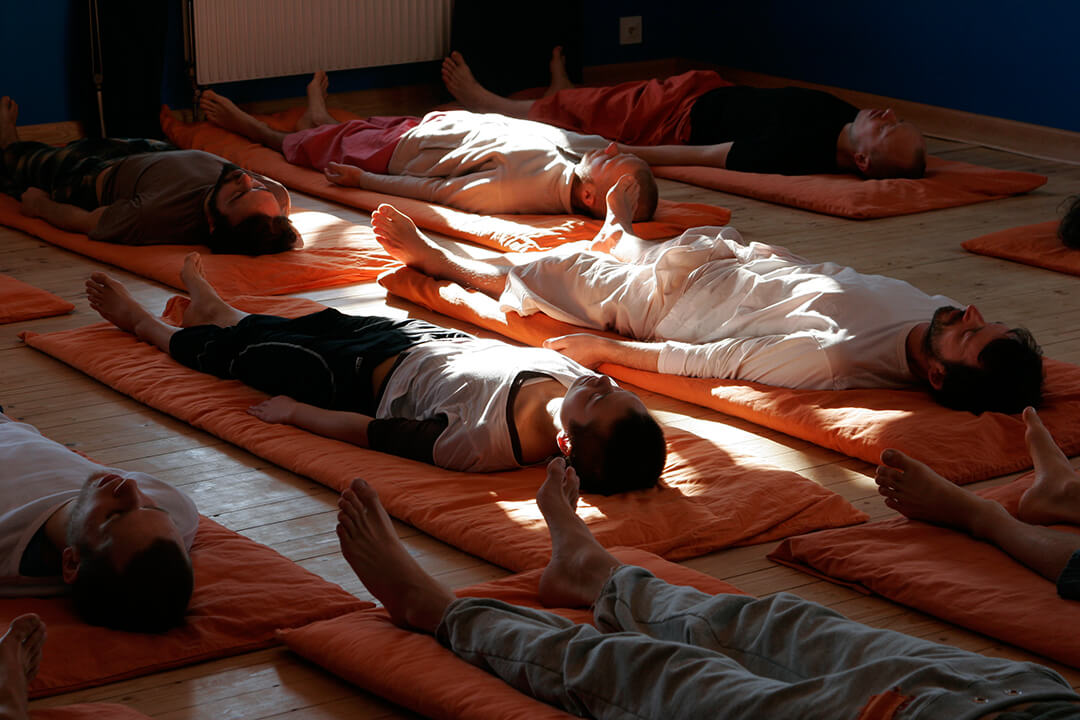Yoga Nidra is equivalent to 4 hours of deep sleep in 1 hour. The yoga instructor will next walk you through a yoga Nidra script to achieve the level of calm you require. Yoga Nidra is about ‘conscious relaxation’ rather than ‘conscious effort.’
What is Yoga Nidra – In current usage, yoga Nidra or yogic sleep is a state of awareness that occurs between waking and sleeping and is usually generated by a guided meditation. The Ancient Hindu Scripture texts like the Upanishads and the Mahabharata both reference a state known as ‘Yoga Nidra’.

What is the best time to do Yoga Nidra?
Yoga Nidra can be done at any time, including when you’re trying to fall asleep in the evening. When you perform it at night, you can use the technique to stay in touch with your conscious mind as you relax—then you may fall asleep. If you are planning to travel to India sooner or later must try to book a Yoga Nidra retreat in Rishikesh we did that at Ekam Drishti Yogshala as well and it was a marvelous rejuvenating experience.
Why One Should Do Yoga Nidra in Daily Routine
Through guided meditation, you will enter a soothing condition for the mind and body during Yoga Nidra. The practice involves both physical and mental tasks that alter brain waves, allowing emotional tension to be released, the nervous system to calm down, and muscles to relax.
As per the study, The ‘Yoga Nidra’ technique dramatically improves the symptoms of people with mild to moderate anxiety and depression whereas patients with severe anxiety and depression symptoms show no substantial improvement.
Benefits of Yoga Nidra
- Physical pain, skeletal-muscular relaxation, and the elimination of obstructions.
- Improve nervous system balance by increasing the production of endorphins, the happy hormones, while decreasing immunosuppressants, noradrenaline, and cortisol levels.
- Harmonization of the two hemispheres and reduction of brain wave rhythm.
- Depression, anxiety, insomnia, headaches, fibromyalgia, chronic fatigue syndrome, and hypertension.
- Four hours of natural sleep is equal to one hour of yoga Nidra practice.
- Personal progress through the development and application of a non-analytical mind.
- Reprogramming the mind and setting goals.
- Improvements in learning, memory, intuition, and creativity.
- Manifestation of our inherent potential and resources on a whim.
- Subconscious cleansing and memory restriction.
- The clarity in dealing with ambiguous situations.
- Being in a deep meditative condition.
- Expansion of altered mental states.
- Harmonization on all levels.
Getting Prepared for Yoga Nidra
- Yoga asanas, including Yoga Nidra, should be done first thing in the morning or last thing in the evening.
- After a full meal, it is not advisable to perform Yoga. A clutter-free, comfortable environment.
- Because some individuals get cold following Yoga Nidra, it’s a good idea to have a blanket on hand.
Complete Technique for Yoga Nidra:
The Yoga Nidra should take about 10-15 minutes to complete. It’s suitable for everyone. Feel free to use your own words to make it feel more genuine.
- Set the stage by having them lie down in a comfortable, peaceful place to begin the yoga Nidra script. “Keep your eyes closed and follow the sound of my voice,” tell them.
- Breathing: Tell them that it is “your time to sit up,” and to “breathe in and out through your nose like you’re blowing up a balloon in your abdomen.”
- Progressive Muscle Relaxation: Have them “squeeze and release every muscle in your body to relax it.” Then guide them through the relaxation process, focusing on each muscle individually, as follows: “Tighten your hands as much as you can, tighter, tighter… and then release.” Tighten your shoulders as much as possible, tighter, tighter… and then let go.”
- Counting Breaths 40-1: Ask them to “breathe in while mentally saying the number ’40’ in your head, then breathe out while mentally saying the number ’39’ in your brain” in a soothing voice. ’38’ is the following inhale, while ’37’ is the next exhale. Continue counting backward until you reach ‘1.’ If you lose track, start over from ’40.” There’s no need to rush,” say nice, supportive things to them. If you miss a number, don’t become frustrated. If your mind wants to sleep or forgets to count, be kind to it. When you hear my voice, take a pause and start counting again.”
- Revolving Awareness: Take them on a comprehensive body tour in a soothing voice. Between naming each portion of their body, take a 3–5 second break.
- Sharing the Light: Now tell them to share the great light in their hearts with the rest of the world. “Imagine sending the golden light that is pouring through your heart to all of the people you love around the world.” Everyone you know: your mother, father, sister, brother, friends, teachers, etc. Consider all the individuals on the planet who could benefit from a little more light in their lives, and send it to them. Imagine the entire world returning your light while you send it to them.”
- “Now breathe into your abdomen and feel that light moving out and in,” says the seventh step. Feel your stomach expand and contract. You are amazing and unique, and the world needs your light. Roll slowly to your side and take your time getting up.”
Is it possible for me to practice Yoga Nidra by myself?
Yoga Nidra is induced by following a set of instructions, comparable to guided meditation. You can listen to a friend read the instructions, but it’s more practical to listen to someone who has expertise than else or record.
Are there any Science-based Yoga Nidra Benefits
While researchers admit that more long-term studies are needed to confirm all of yoga Nidra’s advantages, more research is being conducted.
One study found out that Post-traumatic stress disorder (PTSD) symptoms such as wrath and anxiety were reduced, while sensations of relaxation and calm were raised, according to military combat veterans.
Research showed that Yoga Nidra dramatically reduced stress and anxiety among 80 college students.
100 women with menstrual-related depression and anxiety improved from yoga Nidra therapy as shown by another study.

